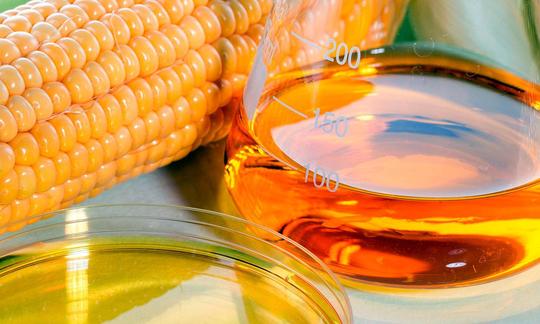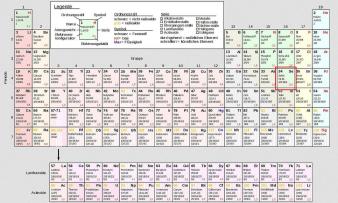Corn syrup, a sugar concentrate made from corn starch, has very little to do with the original product. In America it is called high fructose corn syrup ( HFCS).
Use in the kitchen:
Corn syrup as such is not used in the kitchen. Unfortunately, this sweetener is hidden in many foods, often without the consumer knowing. The chemical name is isoglucose, although it is also made from other starchy plants.
Corn syrup is about five times cheaper than conventional sugar, but has about the same sweetening effect. In the USA, sugar has to be imported and customs duties have to be paid. Subsidies encourage corn cultivation, especially in the USA, Canada and Mexico. These countries produce corn syrup on a massive scale, preferably from genetically modified corn.
It has a wide range of uses. It can be used to replace sugar completely or to add isoglucose. Examples include lemonades, juices, fitness drinks, yoghurt, pudding, ice cream, cakes, biscuits, ready-made products such as ready-made sauces, ready-made salads (!) or canned goods. Fructose-glucose syrup can also be found in bread and rolls. In the USA, the production of corn syrup has replaced the use of household sugar, especially in lemonades and soft drinks. Corn syrup is also mixed into honey there, which is not permitted in Europe.
| Not only vegans or vegetarians should read this: Vegans often eat unhealthily. Avoidable nutritional errors. |
Purchasing:
When purchasing the above-mentioned products in Europe, look for the designation "glucose-fructose syrup" (GFS). The German sugar regulations stipulate that glucose syrup with a fructose content of between 5 and 50% (weight in dry matter) must be labeled as such. If the syrup contains more than 50% fructose, it is called "fructose-glucose syrup" (FGS). 1 The more fructose it contains, the sweeter the product tastes. In Europe, labeling is mandatory when using HFCS. In America, HFCS-42 or HFCS-55 is usually used, but there is also HFCS-90, which the industry often adds. To explain: the dry matter of HFCS-55 contains 55% fructose, 41% glucose, approx. 2% maltose and 2% higher carbohydrates. There are hardly any other substances.
Sweeteners or types of sugar are not always clearly visible on the ingredients list of food products - it does not always have to read "sugar". There are around 70 different names for sweetening substances, including whey powder, lactose, maltose, dextrose, starch syrup, caramel syrup, maple syrup, maltodextrin or barley malt extract. In order to confuse consumers, the word sugar is usually placed at the end to create the illusion that there is less sugar in the product.
Ingredients:
Isoglucose consists of grape sugar (glucose) and fruit sugar (fructose). To obtain isoglucose, glucose is produced from starch through enzymatic hydrolysis using enzymes (amylase, glucose isomerase, pullulanase). Starch sources can be: corn, wheat, potatoes, rice, cassava (manioc) and sago. 2 The glucose content can vary greatly, ranging between 20 and 95%. 3
After calcium ions have been removed, glucose is partially converted into fructose by the catalytic action of the enzyme glucose isomerase. 4 This conversion of glucose into fructose has an economic factor. The sweetening power of fructose is higher than that of glucose. This means that the sweetening power of the corn syrup can be increased without requiring more of the starting material. 5 The fructose content in the end product can vary, see above under Purchasing.
The enzymes used are obtained biotechnologically with the help of genetically modified microorganisms 6 ( Bacillus licheniformis, Bacillus subtillis, etc.) 7. The tables below this text show an average product, but USDA does not show the fructose content. In the book " Salt Sugar Fat " by Michael Moss, you can find out why we consumers are in this bad situation and what this sugar does by searching for terms such as HFCS or glucose-fructose syrup.
Health aspects:
This means the following for health: In the widely used high fructose corn syrup, it is no longer glucose that predominates, but fructose (not fructose). The body metabolizes this type of sugar independently of insulin and so it does not lead to a feeling of satiety. From the small intestine, the fructose that is absorbed reaches the liver directly. There, fructose increases fat storage, which promotes inflammation. Fructose also stimulates the craving for sweets significantly more, which is why people eat more sweets. This leads to fatty liver disease more quickly. 8 Other secondary diseases are: overweight and obesity (adiposity), metabolic syndrome, high blood pressure, gout or even chronic kidney damage. 9,10
Dangers/Intolerances:
Excessive fructose consumption can have devastating consequences for people with specific illnesses or intolerances. People with hereditary fructose intolerance (HFI) have a hereditary disorder of fructose metabolism. The body does not break down the fructose sufficiently, which disrupts the metabolism of glucose and leads to hypoglycemia. A strict diet plan must be followed for this rare disease. 11 A milder form of fructose intolerance is fructose malabsorption (intestinal fructose intolerance). This intolerance affects far more people. The fructose reaches the large intestine due to incomplete absorption in the small intestine, causing symptoms such as diarrhea, flatulence and pain. One reason for the growing increase in this intolerance is the wide range of uses of fructose in the food industry. 12
General information:
Since the fall of the European sugar market regulation (1 October 2017), the price level for sugar within Europe has been falling. The lower price has since led to an increased use of sugar.
Isoglucose (high fructose corn syrup, HFCS) was not an interesting product for European countries for a long time due to the high import tariffs. In the first years of the 21st century, the health risks of isoglucose were recognized in the USA, which is why countermeasures were taken there too. Many production facilities had to close. Since the end of September 2017, however, there has no longer been a quota system for isoglucose in Europe. The import of isoglucose into the EU was limited to 5%, but now the European market is open to this sugar substitute. This decision is economically motivated and detrimental to health, as warned by the German Obesity Society (DAG) and the WHO. 13,14
Chemically speaking, isoglucose has the same energy content as sucrose (table sugar). According to the Max Rubner Institute, isoglucose is no more harmful to human health than other added sugars (sucrose). As long as the amount consumed remains the same. 15 However, this is not true, as the metabolism of corn syrup in the liver damages the liver in a similar way to alcohol. The problem also lies in the amount used and the constantly increasing consumption of sugar. The production volume is expected to triple in the next few years.
The production of corn syrup is significantly cheaper and no longer has to be taxed. It is therefore quite possible that isoglucose will push domestic sugar out of the market. If stricter regulations are not developed for the use of isoglucose, this could have disastrous consequences for the health of many Europeans. America is leading the way!
Literature / Sources:
- BMJV Federal Ministry of Justice and Consumer Protection Germany. Sugar Regulation. 2003.
- Becker T, Breithaupt D, et al. Biotechnology. Ullmann's Encyclopedia of Industrial Chemistry, 7th edition, Wiley-VCH, 2011. ISBN 978-3-527-32943-4. Volume 6, p. 48.
- BeMiller JN, Whistler RL. Starch: Chemistry and Technology (= Food Science and Technology). 3rd edition. Academic Press: New York. 2009.
- Wikipedia Isoglucose.
- Wikipedia corn syrup.
- Transgen.de Isoglucose.
- The Amylase Research Society of Japan: Handbook of Amylases and Related Enzymes. Elsevier. 2014:195.
- NDR.de Isoglucose: Sugar syrup causes diabetes. 2017.
- Johnson R, Sanchez-Lozada LG, et al. The effect of fructose on renal biology and disease. Journal of the American Society of Nephrology. Dec.2010;21(12): 2036-2039. doi:10.1681/ASN.2010050506.
- Sugar: The Bitter Truth - Presentation by Robert H. Lustig, MD, Professor of Pediatrics in the Division of Endocrinology, University of California [Series: UCSF Mini Medical School for the Public 7/2009 [Health and Medicine] [Show ID: 16717] (Youtube)].
- Wikipedia Hereditary fructose intolerance.
- Wikipedia Intestinal fructose intolerance.
- Diabetes.de Isoglucose: Sugar syrup flood expected.
- WHO World Health Organization. Guideline Sugars intake for adults and children. 2015.
- Max Rubner Institute. Nutritional assessment and effects of isoglucose consumption on human health. 2017.








Comments